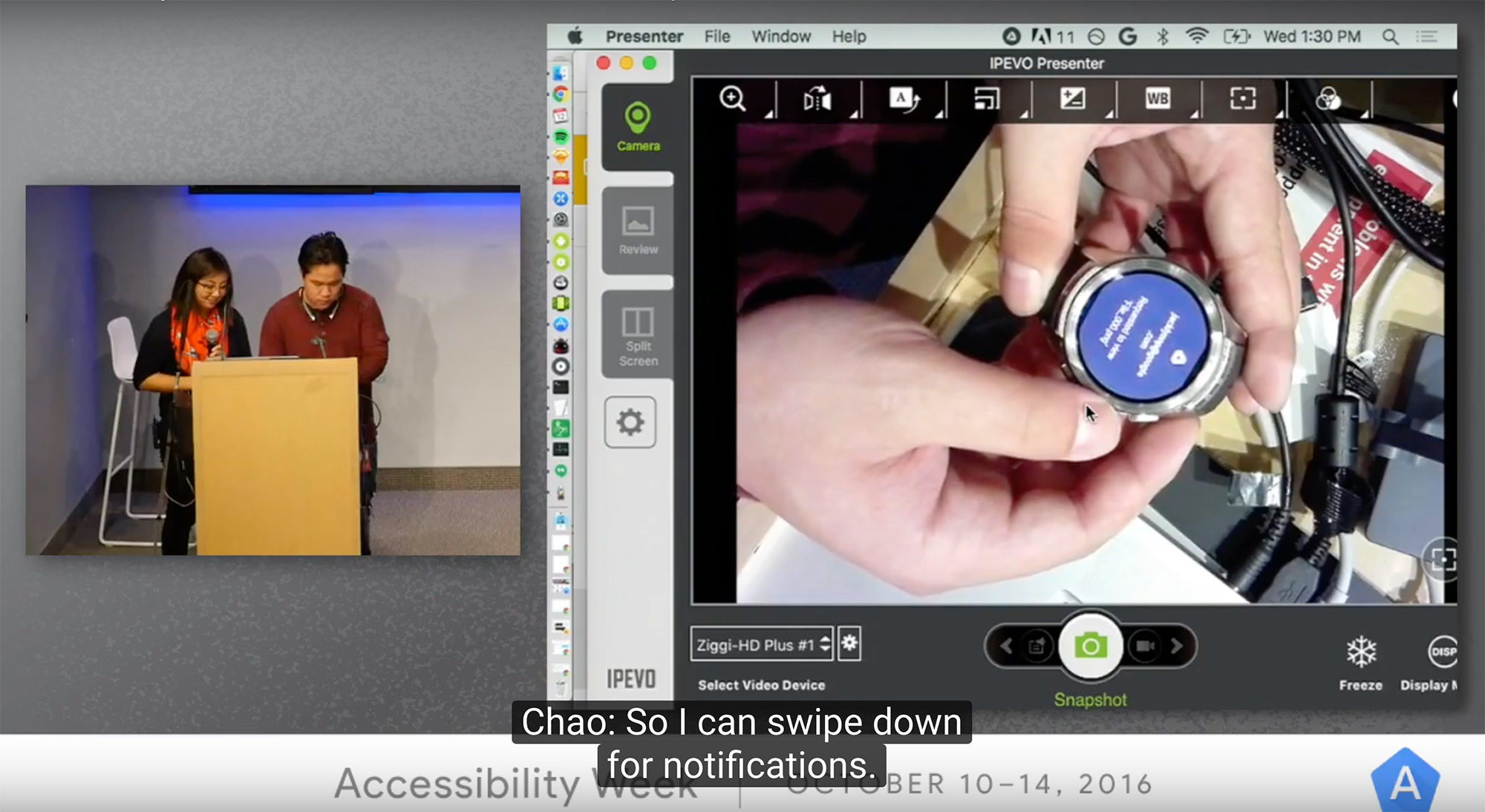Accessibly when used in my work refers to making digital product equally available to everyone, regardless of disability.
The usual story I tell about getting interested in accessibility was when I was assigned to make an app accessible during my internship. There was a short “how-to” presentation that mostly covered things like color contrast and font size. It included a short video of a person who was blind going about her day. She does things like wait for the bus as she runs errands and she demos the screen reader on her phone as she accesses her calendar. It struck me then how different the visual and auditory experience was and it that it didn’t seem fair that her experience should be less thoughtful. Truth be told, this was only my first time encountering accessibility as it intersected with my profession as a designer. I’ve been lucky that I’ve been exposed to stories of disability throughout my life.
I was telling Igor recently that I was sadly-amused when I saw a question asked on a design forum that went something like this: “I want to learn more about inclusive design, but I my internet searches keep coming up with accessibility resources.”
My ‘yes, and’ reaction is that you can’t pick one dimension of inclusivity and call it inclusive—but I know what she meant (she was responding to the BLM movement) and I shouldn’t fault someone for improving their practice. I shared a list of resources on Race, Representation & user experience research that I saw….in an accessibility newsletter I follow, A11y Weekly. (Accessibility is often abbreviated ‘a11y’ because there are 11 letters between the a & y in accessibility)

What sparked my latest reflection on this was finishing reading An Anthropologist on Mars by Oliver Sacks**. Sacks is one of my favorite authors. He was a neurologist and he writes about different neurology case studies in a human and interesting way.
This book covers seven case studies ranging from a painter who becomes colorblind, a surgeon with Tourette’s syndrome, an autistic child with an extraordinary gift for drawing complicated architecture (now 46!), and Temple Grandin, an autistic person who is a renown consultant for the humane treatment of livestock, professor, and lecturer on livestock and autism.

I kept thinking as a progressed through the book how lucky we are to have such a diversity of people that bring different perspectives to the word. Specifically, the neurodiversity of people should be celebrated. In fact, you should read NeuroTribes: The Legacy of Autism and the Future of Neurodiversity** (which I’ve shared before). I details the history of autism from figures from the past who might have autism to our understanding today.
I whole-heartedly reject being called any sort of accessibility expert, but wanted to share some of the things I’ve come across that have influenced my thinking.
** = start here, top recommendations
Things I’ve watched or heard:
Time Bandit** (podcast) – a more recent episode on TAL that I thought was really incredible about someone’s experience with time and social interactions when they have a stutter. It reminded me to give people space to talk and think, which becomes all the more important on video calls all day.
Batman** (podcast)- a story on This American Life that I have shared before: “It challenges how we treat disabled people as a society as people incapable of doing certain things, introducing the idea that disability is a social construct. It centers around the story of this one blind person who was never told he what he could or couldn’t do and so is completely comfortable moving around in the world without assistance. He can ride a bike, go hiking, and climb trees. He uses echolocation.” (quote is something I wrote before, not by a smart person).
My 12 pairs of legs – TED Talk by Aimee Mullins. This TED talk was part of an a11y training I did and I absolutely loved the discussion about our perception of (and sometimes fear) of people with disabilities. Of being taught to turn away. Mullins’ celebrates her disability and encourages us to to change our perspective.
Tommy Edison experience. “Tommy Edison, who has been blind since birth, uses humor to answer the most popular questions about living without sight and faces challenges which test his other senses.” I came across this delightful series during grad school (I think his more famous channel is Blind Film Critic where he reviews movies as a blind person). If you watch even a little bit of the clip you can see how entertaining and fun-loving his videos are.
Game Maker’s Tool Kit YouTube series on the making video games accessible. Scott also knows that I’m interested in accessibility and shared with me this with me. I thought was really interesting even though I play no video games.
I attended this virtual panel on invisible disabilities that my co-worker hosted that I recommend:
The Diving Bell and the Butterfly – Book by Jean-Dominique Bauby and it was also made into a movie**. From the book description: “In December 1995, Jean-Dominique Bauby, editor-in-chief of French ‘Elle’ and the father of two young children, suffered a massive stroke and found himself paralysed and speechless, but entirely conscious, trapped by what doctors call ‘locked-in syndrome’. Using his only functioning muscle – his left eyelid – he began dictating this remarkable story, painstakingly spelling it out letter by letter.”
We discussed this book in my undergraduate seminar class, led by our professor’s daughter who is hard of hearing. We talked about how there can be a public perception that people with disabilities are a whole different category of uncomplicated people. As my co-worker put it recently, portraying them as perfect angels is also dehumanizing. For example, in the movie Bauby is shown lusting after one of the nurses and how that might be different from our idea that people in wheelchairs on devoid of passion.
This reminded me of books I liked growing up that included characters with disability:
- Petey book by Ben Mikaelsen, a fictional story about a man who has cerebral palsy, from birth to old age and people slowly understand cerebral palsy more.
- Flowers for Algernon book by Daniel Keyes. Admittedly about trying to change ones disability, but I remembered really liking it.
- Of Mice an Men book by John Steinbeck, which many of you may have read in middle-high school, like I did.
Books I’ve read as an adult about or with people who have disabilities:

Haben: The Deafblind Woman Who Conquered Harvard Law by Haben Girma. Written by the author, I enjoyed learning about her first hand perspective about her experiences and how they ended up encouraging her to pursue a career in disability rights. I listened to the audiobook, which is read by the author. I recommend this if you like audiobooks because she explains in the book what her higher-frequency voice sounds like and it’s nice to just to read it.

Thinking in Pictures: My Life with Autism by Temple Grandin. After reading Neurotribes, I wanted to learn more about Temple Grandin herself. “Writing from the dual perspectives of a scientist and an autistic person, she tells us how that country is experienced by its inhabitants and how she managed to breach its boundaries to function in the outside world”
I also read an excerpt from Ved Mehta in an Indian writers anthology Carissa gave me. It’s a chapter from a book about boys who are at an institution for the blind who get to read visit the beach. I haven’t read a book with a blind main character (Mehta is blind himself) and have it on my to-read list to read more of his longer works.
As a UX designer, I’ve also read some books about the integrating accessibility into my work:
Accessibility for Everyone by Laura Kalbag — helpful, but I wouldn’t recommend it if you’re not a in the tech space. It gets into practical web-design practice
Mismatch: How Inclusion Shapes Design by Kat Holmes. This would be maybe helpful as your first introduction to accessibility and inclusion, but I was actually kind of disappointed how surface-level it was for me.

Up next: I’m looking forward to reading What a Body Can Do by Sara Hendren, a new book that has been shared excitedly by some of my co-workers.

